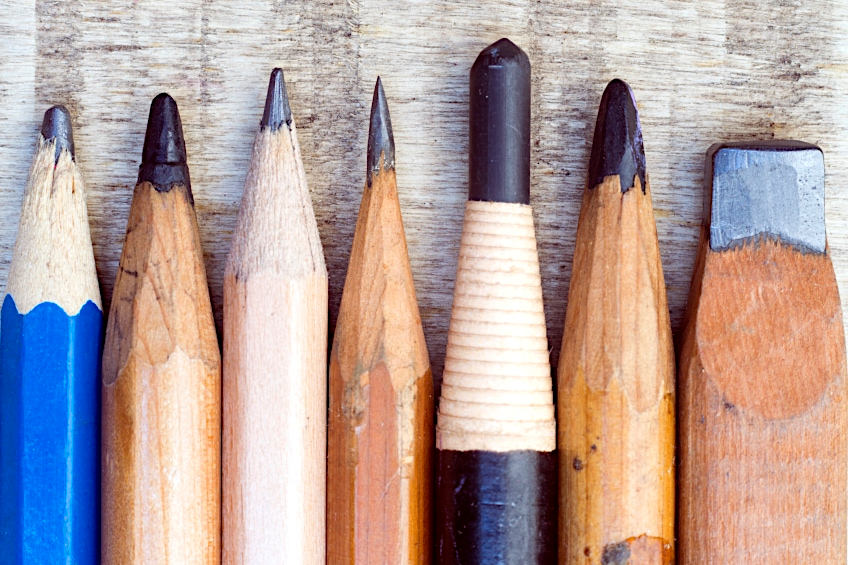
When it comes to drawing and sketching, the type of pencil you use can make a big difference in the final outcome of your artwork. Each type of pencil has its own unique properties and can be used to create different effects. In this blog post, we’ll explore some of the most popular types of pencils used in drawing and sketching and the effects they can create.
Graphite Pencils
Graphite pencils, also known as lead pencils, are the most common type of pencil used for drawing and sketching. They are made of graphite mixed with clay, and are available in a range of hardness levels, from 9H (hardest) to 9B (softest). Harder pencils, such as 2H and HB, are great for fine details, while softer pencils, such as 4B and 6B, are great for creating dark, rich tones.
Charcoal Pencils
Charcoal pencils are made of compressed charcoal, and are available in various hardnesses. They are great for creating strong, dark lines and can be blended with a blending tool to create soft, subtle tones. Charcoal pencils are also great for creating a sense of depth in your drawings.
Colored Pencils
Colored pencils are available in a wide range of colors and are great for adding color to your drawings. They are made of pigments mixed with wax or oil and come in different grades of softness. Some colored pencils are water-soluble, which can be used to create a watercolor effect.
Pastel Pencils
Pastel pencils are made of compressed pastel powder and come in a wide range of colors. They are great for creating soft, delicate tones and can be blended easily to create a variety of effects. Pastel pencils can be used to create a variety of textures, from smooth and velvety to rough and grainy.
Each type of pencil has its own unique properties and can be used to create different effects. It’s always good to experiment with different types of pencils to find the one that best suits your style of drawing and sketching.
Digital Devices and the Evolution of Drawing and Sketching
Gone are the days of traditional pencils and sketchpads. Today, digital devices have revolutionized the way we draw and sketch, making the process faster, more efficient, and more versatile. With the advent of digital technology, the traditional tools of drawing and sketching have been replaced by digital pens, stylus, tablets and computers.
Digital Pens and Stylus
Digital pens and stylus are designed to mimic the feel and movement of traditional pencils and pens. They are used in conjunction with digital tablets, such as the Wacom tablet, to create digital drawings and sketches. These digital pens and stylus come in different sizes and styles, and they can be used to create a variety of effects, such as fine lines, broad strokes, and blending.
Digital Tablets
Digital tablets, such as the Wacom tablet, have revolutionized the way we draw and sketch. They allow artists to create digital drawings and sketches directly on the screen, using a digital pen or stylus. The pressure-sensitive surface of the tablet can detect the amount of pressure applied, allowing the artist to create fine lines or broad strokes.
Digital Painting and Drawing Software
Digital painting and drawing software, such as Adobe Photoshop, Procreate, Corel Painter, and Krita, have made it possible for artists to create digital drawings and sketches with a high degree of precision and control. These programs provide a wide range of tools and features, such as layers, brushes, and filters, which can be used to create a variety of effects. With the help of these software, artists can create digital art that resembles traditional art with the added benefit of undo and redo options, ability to work on layers and use of a vast array of brushes and tools.
Digital Drawing and Sketching on Smartphones and Tablets
Smartphones and tablets have also become popular devices for digital drawing and sketching. With the help of a stylus, artists can create digital drawings and sketches directly on the screen of their devices, using various digital painting and drawing apps. This makes it possible for artists to create and share their artwork on the go.
In conclusion, digital devices have revolutionized the way we draw and sketch, making the process faster, more efficient, and more versatile. Digital pens, stylus, tablets, and computers, in conjunction with digital painting and drawing software, have opened up new possibilities for artists and have made it possible for them to create digital drawings and sketches with a high degree of precision and control. The traditional tools of pencils, paper and sketchpads are still being used but now artists have more options to choose from and explore. With the help of software, digital art has come closer to traditional art, providing more options and flexibility to the artist.
